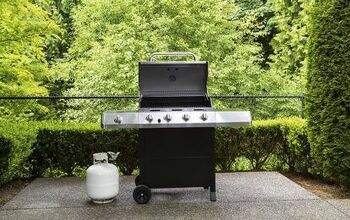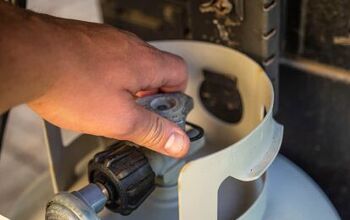How To Empty A Propane Tank (Quickly, Easily & Safely!)

Propane tanks are incredibly useful for homeowners and can be used for everything from home and water heating to providing heat for a barbeque grill. Although under pressure and in a liquid state, propane is not flammable, it does become highly combustible when the fuel is released and converted into propane gas.
With that said, many feel that it’s safest to completely empty a propane tank when the levels inside are too low for practical use. Or, you may need to properly empty and clean a propane tank for welding. Regardless of the reason, emptying out a propane tank makes it safer to both transport and store until the tank is ready to be refilled.
Disconnect the propane tank, take it to an open area, and carefully tilt it onto its side. Open the valve and turn the knob all the way to drain the propane from the tank. Close the valve when you can’t see propane come out anymore and it is empty.
Personal Protective Equipment Recommended for Propane Tanks
The Division of Occupational Safety and Health Administration (OSHA) classifies propane as a “hazardous” material, meaning you must take special care when you’re working with it in gas form. To keep yourself safe, make sure that you are always wearing the following protective equipment whether you are disconnecting, changing, reconnecting, or emptying a propane tank.
- Gloves: Equipping yourself with AS/NZS 2161 approved gloves while working with gas cylinders is crucial to prevent tears and cuts. It will also protect your hands against thermal damage, in the unlikely event of an accident.
- Eye Wear: Regardless of the type of compressed gas you are dealing with, you should always protect your eyes. Even Class 2.2. Nontoxic gases can cause eye damage when they are abruptly released from the tank. Since propane is a compressed gas and is labeled as toxic, protective eyewear must be worn at all times.
- Hearing Protection: This type of PPE only applies if you are going to be welding the propane tank after it is emptied. When welding, there is always the possibility that spars could erupt or the tank could explode. Therefore, make sure that you wear AS/NZS 1270 approved hearing protection when you are welding a propane tank.
- Breathing Equipment: As previously mentioned, propane is toxic and when you’re working with it in gas form, you must wear an AS/NZS 1716 recommended breathing apparatus to keep your lungs safe.
- Safety Footwear: Propane tanks are considerably heavy and can cause substantial damage to your feet if they fall or you accidentally drop them. Wearing appropriate safety footwear can help to protect your feet from a number of possible fractures or breaks. It is recommended that you wear footwear that is AS/NZS 2210.2 approved. You can also refer to AS/NZS 2210.1 for guidance and tips and the best footwear to use.
How to Empty a Propane Tank
Now that you are aware of the necessary protective equipment for emptying a propane tank, we can explore the proper steps. Here they are at a glance:
- Disconnect the tank
- Move the tank to an open space
- Title the tank to the side
- Open the valve
- Double-check for gas remnants
- Close the valve
Let’s dive in!
Step One: Disconnect the Tank
First, detach the propane tank from any hose attachments and close the valve. Depending on the particular valve attachment, gas may or may not leak out after you’ve disconnected the hose. More modern tanks are outfitted with a plunger, adding safety and preventing gas from escaping.
If your tank does not have one of these safety plungers, make sure that you have your gloves on before you disconnect any of the attachments. This is especially important if you are dealing with a propane tank that is full.
Step Two: Move the Tank to an Open Space
If the propane tank has a lot of gas, it’s best to move it to an open area prior to opening a valve. The outdoor location you choose should not be within 10 feet of any buildings, trees, shrubbery, or other humans. Propane can be toxic to greenery and may cause damage to anything it comes in contact with.
Choose an open-air location or clearing that has plenty of ventilation. That way, the gas can safely dissipate upon release.
Step Three: Tilt the Tank to the Side
Position the tank to the side, so that the valve is pointed sideways. This serves as a precautionary step and will make emptying the gas out of the tank much easier to manage. It will also guarantee that most, if not all, of the gas escapes the propane tank.
Step Four: Open the Valve
With the propane tank tilted sideways, open the valve until you cannot turn the knob anymore. Step back until you can no longer visually see or hear propane escaping from the tank. Then, close the valve.
Step Five: Double Check for Gas Remnants
To ensure that there aren’t any remnants of gas left in the tank, connect the tank to your grill and open the valve. Then, attempt to light up your grill. This will cause any remaining gas to be used up in the fire.
It is crucial that you do not skip out on this step, as any trace amounts of flammable propane gas left behind can be deadly. This is especially true if you are empty the propane tank for welding, as leftover gas is an accident waiting to happen.
Step Six: Close the Valve
The odor that is left behind after all the propane has exited the tank can also be hazardous. If you start welding with the valve still open, the lingering scent can cause a fire. The last thing you want is your tank blowing up in your face while you’re welding. So, make sure that you close the valve after you’ve finished emptying the propane tank.
How to Safely Use and Store a Propane Tank
Per the safety guidelines outlined by OSHA and the Compressed GS Association (CGA), one must adhere to the following procedures when using and storing a propane tank.
- Always wear the necessary gloves and other Personal Protective Equipment (PPE) when you’re working with propane tanks.
- Never use the cylinder in an improper orientation, whether it’s full or empty.
- According to OSHA, proper orientation of grill gas cylinders is having the tank situated in a vertical and upright position.
- When the cylinder is not in use, make sure that the valve is closed. While some tanks come with a plunger to prevent gas from leaking, you should still close the valve.
- Tanks used for forklifts may be stored vertically or horizontally. However, when stored horizontally, the relief device must be situated at the 12 o’clock position.
- Store propane tanks that are currently not in use outside in an open-air storage container or cage that has a protective roof. The storage area must be at least 20 feet from other structures.
- Never store a propane tank in your garage, whether it’s full or empty.
- When you need to change or refuel your propane tank, follow the pertinent LP powered device training documentation.
- Verify the requalification date on the cylinder’s collar before each refueling. The tank should be exchanged if the requalification date has expired or is close to it.
Related Questions
How long do propane tanks last?
As a general rule of thumb, one tank of propane will usually last you between 18-20 hours, provided you are grilling on a medium-sized grill. However, larger grills often burh through around 20 pounds of propane in just 10 hours. You can expect to use an average of one to two pounds of propane per meal if you’re cooking with a medium-sized grill on high heat.
How often do propane tanks need to be replaced?
Propane tanks need to be requalified, or replaced, every 5 to 10 years. However, the exact time will depend on the condition, type, and previous requalification method for the particular cylinder.
How do you tell if your propane tank is expired?
The easiest way to know if your propane cylinder is nearing expiration is to check the collar, or handle area. While this won’t give you the exact date that the propane tank expires, it’ll tell you when the tank was last certified or when it was manufactured. With this information, you can determine how much life the tank has left, or if it may be time to requalify it.
What do you do with expired propane tanks?
If your propane tank is expired, you can swap it out for a new one. This can be easily done at most hardware stores. Or, if you simply want to dispose of it, contact your supplier or a hazardous waste collection company in your area. Alternatively, you can refurbish the tank and put them to use.
Final Thoughts
When working with propane, whether it be in liquid or gas form, it is crucial that you follow safety guidelines and wear the PPE recommended by OSHA. This will help keep you protected during the disconnection, reconnection, changing, and emptying processes. As long as you take the necessary steps to protect yourself, emptying a propane tank can be done successfully and safely in six simple steps!
Related Guides

Jessica considers herself a home improvement and design enthusiast. She grew up surrounded by constant home improvement projects and owes most of what she knows to helping her dad renovate her childhood home. Being a Los Angeles resident, Jessica spends a lot of her time looking for her next DIY project and sharing her love for home design.
More by Jessica Stone



























